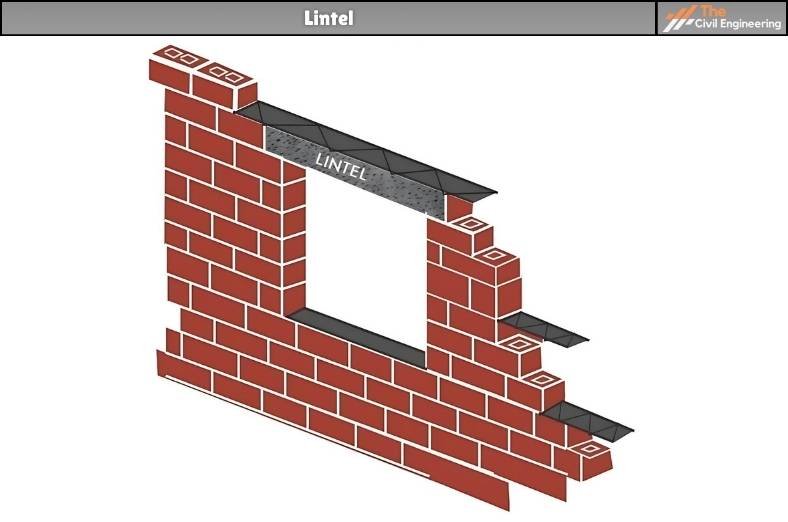Lintel can be defined as the beam that is placed above the door and window openings to withstand the incoming load from the above structural elements.
✔ The lintel is also called a lintel beam.
✔ Lintel refers to the structural element that is provided at the lintel level of the building.

✔ The primary objective of providing the lintel is to support the openings in the wall by transferring the incoming load to the adjacent surrounding wall.
1. Functions of Lintel
Some of the major functions served by the lintels in the buildings can be listed as follows:
a. It provides additional strength to support the incoming loads to the doors and windows openings.
b. It provides support and imparts stability to the walls above the door and window openings.
2. Types of Lintel
Lintels can be classified based on the construction materials used. They are:
a. Timber Lintel
b. Stone Lintel
c. Brick Lintel
d. Reinforced Brick Lintel
e. Reinforced Concrete Lintel
f. Steel Lintel
a. Timber Lintel
~ As the name itself implies; timber is used as the chief construction material in timber lintel.
~ Only well-seasoned timbers are used for the lintel construction.
~ Timber lintel is extensively used in the areas where timber is found in abundance.
~ Nowadays, to increase the strength and stability; steel plates are added to the upper and bottom parts of the timber lintel. Such type of reinforced timber lintel is known as a flitched lintel.
~ Timber lintel is economical and can be constructed easily with locally available timber. However, this type of lintel is susceptible to damage by rotting and firing.
~ Timber lintel offers a low degree of durability and does not have high strength.
b. Stone Lintel
~ Stone lintel is the type of lintel that is constructed by using stones as the chief construction materials.
~ The stone lintel is used extensively in the areas where buildings stones are found in abundance.
~ Usually, stones in the form of rectangular bands about 4cm thick are used as a lintel.
~ Stone lintel is widely used in windy and mountainous regions.
~ Stone lintel is heavy and thus transportation and handling can be difficult.
~ This lintel is not desired in seismically active zones.
c. Brick Lintel
~ Brick lintel is constructed by using well-burnt first-class bricks as the chief construction material.
~ Several bricklaying techniques can be used for the lintel construction such as bricks may be laid on the edges, on the end, or horizontally over the door and window openings. This type of lintel is desired in the light type of construction.
d. Reinforced Brick Lintel
~ As the name itself implies; It is the brick lintel that has been provided with reinforcement.
~ The main aim of providing the reinforcement bars is to increase the strength and load resisting capacity of the ordinary brick lintel. In general, the depth of reinforced lintels is kept multiple of one brick thickness of 10cm.
~ Usually, the bricks are reinforced by providing mild steel bars at a suitable gap. The gap in between the successive mild steel bars is filled with mortar.
~ Reinforced brick lintel is suitable for heavy loadings as well as longer spans.
e. Reinforced Concrete Lintel
~ The reinforced concrete lintel is the type of lintel that constitutes reinforced concrete as the chief construction material.
~ It is suitable for heavy loadings as well as longer spans.
~ It has high strength & stability and is widely used in modern-day constructions.
~ It also offers a good degree of durability and has good resisting properties. Pre-cast concrete lintels can also be used for small spans.
f. Steel Lintel
~ Steel lintel consists of steel as the chief construction material.
~ Usually, rolled steel sections and channel steel sections are used for the construction of steel lintel.
~ Steel lintel offers good resistance even to heavy loadings.
| Read More: Total Station in Surveying |
| Read More: Plinth Level |


